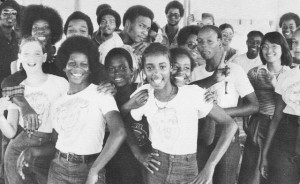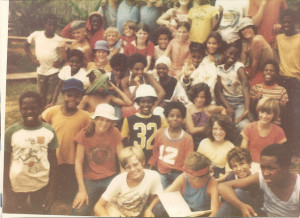 Photography is one of the visual art forms that has been used to portray the memories of life in Jonestown. Although the number of existing photographs may be limited, the ones that were preserved provide more than color and visual effect. They share the experiences and emotions of what daily life was like in the agricultural commune. They combine with the personal narratives of those who lived in Jonestown and survived. The photography comes to life to give us a deep understanding which informs our cultural memory of Jonestown.
Photography is one of the visual art forms that has been used to portray the memories of life in Jonestown. Although the number of existing photographs may be limited, the ones that were preserved provide more than color and visual effect. They share the experiences and emotions of what daily life was like in the agricultural commune. They combine with the personal narratives of those who lived in Jonestown and survived. The photography comes to life to give us a deep understanding which informs our cultural memory of Jonestown.
This essay seeks to provide a historical phenomenology of the life and emotions shared through the photography of Jonestown. Through phenomenology, we attempt to describe the common meaning of lived experience. Data for this study will consist of about 2,200 photographs of Jonestown and correspondence with Laura Johnston Kohl, the manager of the Jonestown Flickr Photographic Archive and herself a Jonestown survivor [Editor’s note: Since Laura’s death in 2019, the management of the Flickr site has been assumed by Rebecca Moore]. Using phenomenological analysis, I hope to elucidate some of what the photography of Jonestown can tell us.
* * * * *
When considering these photographs, we should remember that social change has many varying influences that may alter our interpretations of historical events. We should try to view the images of Jonestown within the cultural framework of the time and place in which they occurred and through the perspectives of the people who experienced it. Most Jonestown residents were common people working hard to build their community and to create a good life for themselves and their comrades. Working to build a community the size of Jonestown was not easy and involved a diverse array of human relationships.
According to Laura Johnston Kohl, the Jonestown photographs were completely spontaneous. She does not remember ever being asked to stage a photo or – for that matter – even seeing anyone with a camera. As a result, she believes the photographs were authentic and captured the true emotions of Jonestown residents. She was very happy at Jonestown, she adds, and although she feels the majority of people felt as she did, there are some who disagree.
There may be some omission in the photographs, because they do in fact predominantly depict moments of activity and play, of industry and accomplishment and happiness. The moments that contradict the sanctioned message of the Jonestown leadership were not recorded on film. However, this omission is no different from photos of families and groups of friends. Most people do not want to preserve unhappy moments. It is human nature to want to remember valued activities in the community and to portray times of happiness.
Another possible reason provided for the relatively small number of photographs – and for the selectivity in the nature of the photographs – is the technology that was available in the 1970’s. Digital cameras, computers, iphones, and computerized in-store photo machines did not exist in the 1970’s. Developing a roll of film required the photographer to go to a commercial developer like a drug store – the nearest of which was 24 hours away in Georgetown – or a dark room, which Jonestown did not have. This would have been an expensive and laborious task that would have limited the quantity of photographs. It may also have restricted the willingness to fully document every event within Jonestown, especially those which were not viewed positively.
 The cultural differences of the time and location should also be noted in this discussion. People worked hard in Jonestown, but there was less stress in the agricultural commune and in society in general in the 1970’s. Moreover, society lacked the modern communications systems – again, I’m referring to digital technology – that are available today. In order to live, work, shop, and develop relationships people had to have face-to-face interaction. Even in the isolation of Jonestown, human relationships would have been dependent on relating with the actual people in the community, relationships which tend to evoke more empathy, understanding and sense of common purpose. The fact that the residents of Jonestown lived with longstanding friends and family members would likely have made the photography more intimate.
The cultural differences of the time and location should also be noted in this discussion. People worked hard in Jonestown, but there was less stress in the agricultural commune and in society in general in the 1970’s. Moreover, society lacked the modern communications systems – again, I’m referring to digital technology – that are available today. In order to live, work, shop, and develop relationships people had to have face-to-face interaction. Even in the isolation of Jonestown, human relationships would have been dependent on relating with the actual people in the community, relationships which tend to evoke more empathy, understanding and sense of common purpose. The fact that the residents of Jonestown lived with longstanding friends and family members would likely have made the photography more intimate.
* * * * *
Photographic Analysis: The photographs reviewed were primarily taken from the Peoples Temple Flickr site. Other photographs are housed at the California Historical Society, at Special Collections of the San Diego State University Library, and on this site, both those collected at its Gallery page and those scattered among remembrances and reflections.
Comparison was made of photographs taken by Peoples Temple before Jonestown and the photos taken in Jonestown. Similar themes in both sets of photographs likely emanate from the progression of similar ideology. A leftward leaning divergence appeared in the later photography of Jonestown – around the year 1978 – during which time radicalization of ideology may have occurred.
The characteristics of the photography of the early Peoples Temple and of Jonestown maintain a similar theme of authenticity, equality, and member centricity. There are only a few photographs of Jim Jones in the collection, and in most of these, he appears with other Temple members. The majority of Jonestown photography seems to emphasize group activities and the work of group members to build and maintain life in the community. The photographs include people of all ages – a negation of ageism – and place importance on the children of the community. They portray all ethnic backgrounds and both genders in an equal light. Typical group shots may show activities related to various aspects of work, school, medical treatment, construction, agriculture, and play. There are few photographs of leadership activities, or indeed of the leaders themselves. Although there is not as much emphasis placed on individual photos, a surprising number of the ones that do exist show members involved in work or group activities, and the smiles and postures of individual peoples appear natural and spontaneous.
Photographs depicting physical objects – as opposed to people – emphasize the articles of work such as buildings, workspaces, churches, cultivated fields, and artwork. Photos of the natural foliage that surrounded Jonestown give testimony to the beauty of the region and work involved in building the community.
Comparison was made between the pictures taken by Jonestown photographers, and those taken by corporate media about Jonestown. This led to the conclusion that the photography of Jonestown was an authentic and spontaneous representation of the lives and worldview of the members of Peoples Temple. Jonestown’s in-house photography, so to speak, appears to have been too humanistic and ideological to contribute to the narrative about life in the community which held sway in the aftermath of the deaths. Rather, photography by corporate media appears to have been marketing-oriented, reinforcing what everyone thought they knew about Jonestown. This may have led to a loss of voice of the original message told by the members of Jonestown about their mission and ideology.
While the photographs recently released by the FBI seemed relatively uncontroversial, the photographs of Jonestown documents also released by the FBI prove quite revealing of the beliefs of the releasing agency. While the photos emphasize the social structures and racial beliefs of Temple members, the photographed documents include two of the three notes written on the last day of the Temple’s existence… and very little else from the thousands of less dramatic pages. A full release of all documents relating to Jonestown for unbiased study would help to fulfill the wish of those who perished that their example of equality and social justice become a monument to life and the human spirit.
The photography of Jonestown portrays a social movement of people who believed in taking action to achieve their vision of equality. It cuts through the media mist to give voice to a people who worked to improve the world in which they lived. The beauty of the photography of Jonestown is that it creates a realism in which we are able to view often nameless Temple members, laboring to build the utopian community in which they believed. It was the work of the people, the unheard Temple members, who star in the photography of Jonestown.
(Edward Cromarty is a frequent contributor to the jonestown report. His complete collection of articles is here. He can be reached at edwardcromarty@hotmail.com.)